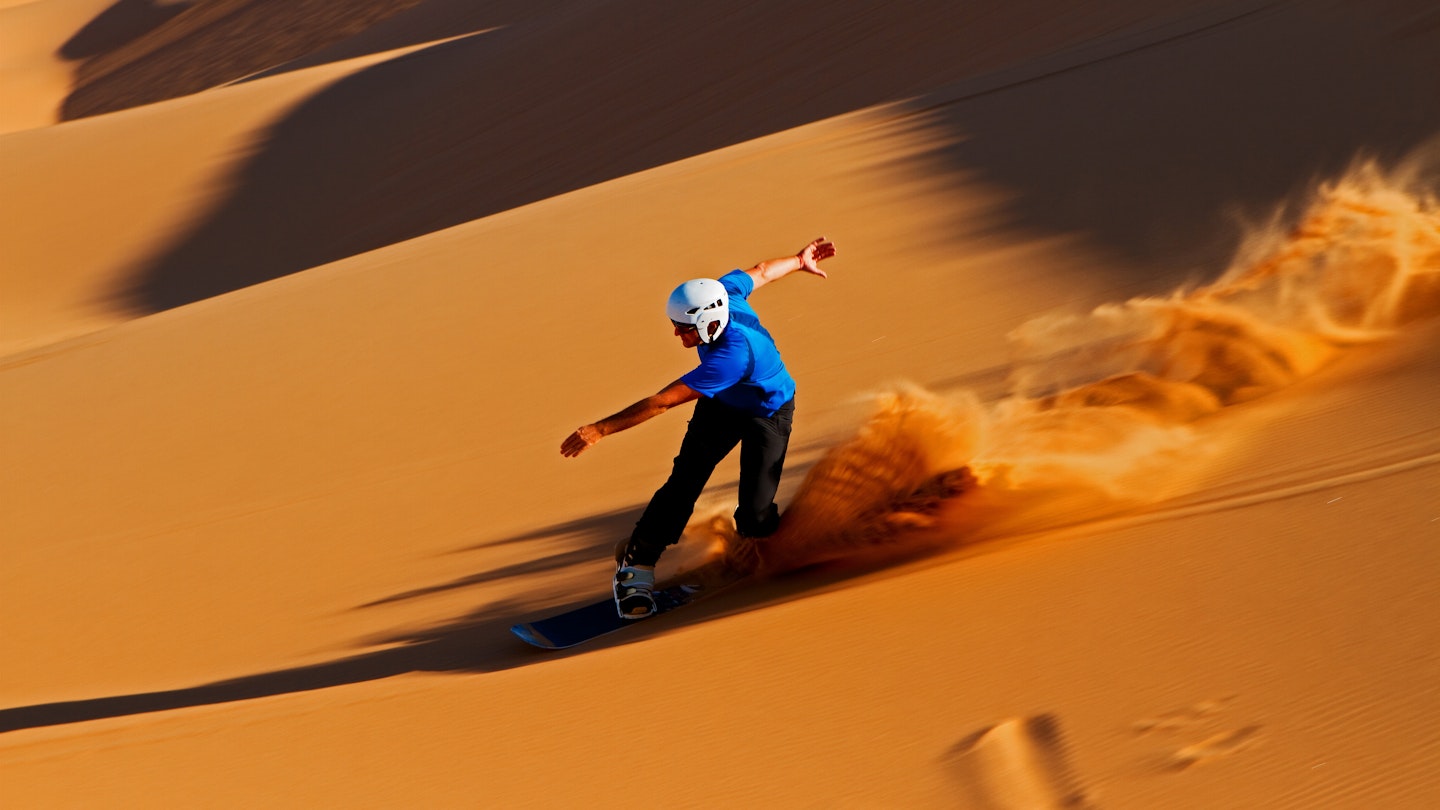Ocean and desert collide in Namibia to provide adventure playgrounds of water, sand, and rock, with each as vast (and wild) as the other.
Namibia’s landscapes are epic, both in terms of sheer scale and natural beauty. Imagine singing sands and dunes that climb to more than 300m (985ft) in height and look more like works of art than anything produced by the blowing winds. Picture yourself hiking across their undulating crests and looking across an ocean of mammoth waves frozen in sand. If you feel like boarding down one of those waves, that’s an option too.
Moreover, the Namib Desert, which gave the country its name, is more than just a huge sandbox. It’s also home to tortured mountains and rocky canyons. These captivating environments are ripe for explorations on foot or mountain bike.
Soaring inselbergs such as Spitzkoppe are great places to cling to if you have a penchant for rock climbing. Flanking the entire country’s west, running almost 1600km (994 miles) from South Africa to Angola, is a wild coastline with a history of sinking ships, providing a perfect backdrop for adventure.
Dune Boarding
The Namib is arguably the world’s oldest desert, but there’s a new way to experience its dunes: on a board. Not far from Namibia’s coastal town of Swakopmund, mountains of sand provide perfect slopes to carve down.
When you first set eyes on the dunes rising high into the blue African sky, you’ll begin to buzz with anticipation; however, it’s wise to conserve a little energy. Your journey starts with a hike up to your launching point. With board, gloves, and goggles in hand, you’re eventually staring down at some serious off-piste action. Strap in, lean back further than you’re used to, and let loose!
Once you’ve had your fill, try the lie-down “schuss” option, which will see you hit speeds of 80km/h (50 mph). This exhilarating experience is one not to be missed.

Rock Climbing
Rising like a mirage above the desert plains of southern Damaraland, the behemoth 1728m-high inselberg that is Spitzkoppe has long inspired climbers. Although first summited in 1946, its granite flanks continue to attract hardcore climbers aiming to tackle the nation’s most challenging peak.
Moreover, some of the lower, rounded domes offer thrilling scrambling for those who aren’t as keen to tackle vertical pitches. At night, camping below it all provides a celestial show like no other.
Skydiving
Seeing the large swells of the cold southern Atlantic Ocean crashing into the delicate-looking desert dunes is compelling. However, experiencing this while free-falling toward Earth at 220km/h (137 mph) is an adventure of a lifetime. The incredible aerial views of the desert landscape and ocean during the 25-minute flight to the jump zone are worth the trip.
The deafeningly exciting free fall from 3000m (9843ft) lasts approximately 30 seconds before your parachute deploys at 1500m (4921ft). This thrilling experience is available for beginners, with tandem jumps offered for those looking to take the plunge.
Kitesurfing
Harnessing the power of the winds along the Atlantic coast is a thrilling challenge. Novices can learn the ropes with power kiting lessons, while those with skills can take on kitesurfing courses in the Atlantic. Moreover, basic landboarding lessons on the Namib’s sands are also available, providing a great introduction to this exciting sport.

Mountain Biking
Imagine Moab, Utah—amazing, right? Now imagine it sitting empty. Welcome to Namibia! Here, there are numerous compelling trails and dramatic scenery from rollercoaster singletracks outside of Swakopmund to tricky jeep routes around dry riverbeds.
Moreover, without the distraction of heavy traffic on the country’s graded gravel roads, multi-day mountain bike expeditions become a fantastic option. A good starting point is near Aus in southern Namibia.
Hot Air Ballooning
The Namib-Naukluft National Park, spanning almost 50,000 sq-km (19,305-sq-mile), is home to some of the planet’s most spectacular dunes, especially around Sossusvlei. The winds have shaped bright orangey-red sands into elegant parabolic shapes, and viewing this unique desert landscape from the air is a truly spellbinding experience.
Hot air balloon rides are possible in the early morning. These rides provide an unforgettable experience, often including a champagne breakfast upon landing.

Hiking
Between hard rocks or atop soft sands, hiking in Namibia offers extremes. These can vary from short explorations of large dune fields, especially around Sossusvlei, to serious endeavors like the five-day trek through the depths of one of the world’s largest canyons.
Due to soaring summer temperatures and the remoteness of the Fish River Canyon floor, hikes in the canyon are limited to May through mid-September. The enchanting and challenging 85km (53-mile) route from Hobas to Ai-Ais traverses boulder fields and ephemeral pools, perfect for dips to beat the heat.
Other notable hikes include four- and eight-day loops through the Naukluft Mountains, offering a more subtle charm than the Fish River Canyon. Additionally, the unique mineral composition of the Namib’s sand in certain areas resonates a hum when disturbed, creating a captivating auditory experience.

Surfing
With nothing standing between Brazil and the coast of Namibia, there is no shortage of large south Atlantic swell to ride. Sharks, seals, sand storms, and incredibly remote breaks mean there’s assurance of adventure as well. A great place to start is in Swakopmund, where the waves at Nordstrand near Vineta Point provide particularly good conditions.
Tiger Reef, at the mouth of the Swakop River, is another solid option, along with Bocock’s Bay, known for its exceptionally long left-hand point break. The consistent surf here is likely to be all yours. April and May tend to be the best months for surfing in Namibia, although any time from March to October is rewarding.
In summary, Namibia offers an array of thrilling activities for adventure enthusiasts. From soaring dunes and magnificent landscapes to challenging mountain peaks, Namibia is a playground for those seeking excitement in nature.




